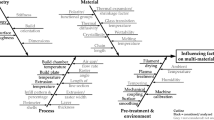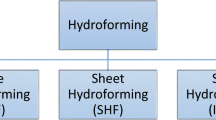Abstract
Three-dimensional (3D) printing technology can be used to easily and rapidly produce complex shapes. In this study, an electrode tool used for electrochemical machining (ECM) was fabricated using a 3D fused deposition modeling (FDM) printer. The electrode tool was made from acrylonitrile butadiene styrene (ABS), a low-cost material commonly used in 3D printing. Since the electrode printed with ABS material is non-conductive, additional conductive coating was applied to the tool surface. Electrical conductivity characteristics and coating thicknesses were analyzed with respect to the number of coatings to identify optimal coating conditions. The ECM performance of the fabricated electrode was then compared with that of a conventional copper electrode tool. The effect on the shape of the 3D printing electrode during machining according to the type of coating was analyzed. The thermal effect of the current applying had to be considered, and a suitable coating type was selected based on the experimental results. The fabricated ECM electrode can achieve significant machining quality to the existing electrode performance, and through the results of this study, it was possible to increase sustainability in the manufacturing industry with advanced machining technology.
Similar content being viewed by others
References
M. M. Lohrengel, K. P. Rataj and T. Münninghoff, Electrochemical machining-mechanisms of anodic dissolution, Electrochimica Acta, 201 (2016) 348–353.
T. Shimasaki and M. Kunieda, Study on influences of bubbles on ECM gap phenomena using transparent electrode, CIRP Annals, 65(1) (2016) 225–228.
A. Gomez-Gallegos, F. Mill, A. R. Mount, S. Duffield and A. Sherlock, 3D multiphysics model for the simulation of electrochemical machining of stainless steel (SS316), Int. J. Adv. Manuf. Technol., 95(5) (2018) 2959–2972.
X. L. Fang, X. H. Zou, M. Chen and D. Zhu, Study on wire electrochemical machining assisted with large-amplitude vibration of ribbed wire electrodes, CIRP Annals, 66(1) (2017) 205–208.
E. S. Lee, J. W. Park and Y. H. Moon, A study on electrochemical micromachining for fabrication of microgrooves in an air-lubricated hydrodynamic bearing, Int. J. Adv. Manuf. Technol., 20(10) (2002) 720–726.
U. S. Kim, N. Morita, D. W. Lee, M. Jun and J. W. Park, The possibility of multi-layer nanofabrication via atomic force microscope-based pulse electrochemical nanopatterning, Nanotechnology, 28(19) (2017) 195302.
A. D. Davydov, V. M. Volgin and V. V. Lyubimov, Electrochemical machining of metals: fundamentals of electrochemical shaping, Russ. J. Electrochem., 40(12) (2004) 1230–1265.
T. Koyano, A. Hosokawa, R. Igusa and T. Ueda, Electrochemical machining using porous electrodes fabricated by powder bed fusion additive manufacturing process, CIRP Annals, 66(1) (2017) 213–216.
Y. B. Kim and J. W. Park, Corrosion rate evaluation of pulse electrochemical polishing for stainless steel, Adv. SCI LETT, 14(1) (2012) 227–230.
Y. B. Kim and J. W. Park, Effect of pulse time on surface characteristics and corrosion resistance during pulse electrochemical polishing, Trans. Nonferrous Met. Soc. China, 22 (2012) s876–s880.
J. M. Lee, Y. B. Kim and J. W. Park, Pulse electrochemical meso/micro/nano ultraprecision machining technology, J. Nanosci. Nanotech., 13(11) (2013) 7741–7744.
J. Yao, Z. T. Chen, Y. J. Nie and Q. Li, Investigation on the electrochemical machining by using metal reinforced double insulating layer cathode, Int. J. Adv. Manuf. Technol., 89(5–8) (2017) 2031–2040.
M. K. Thompson et al., Design for additive manufacturing: trends, opportunities, considerations, and constraints, CIRP Annals, 65(2) (2016) 737–760.
L. F. Arenas, C. P. de León and F. C. Walsh, 3D-printed porous electrodes for advanced electrochemical flow reactors: a ni/stainless electrode and its mass transport characteristics, Electrochem. Commun., 77 (2017) 113–137.
V. V. Lyubimov, V. M. Volgin, U. Mescheder, I. V. Gnidina and A. S. Ivanov, Investigation of plastic electrode tools for electrochemical machining of silicon, CIRP Annals, 47 (2017) 546–556.
J. Tak, D. G. Kang and J. Choi, A lightweight waveguide horn antenna made via 3D printing and conductive spray coating, Microw. Opt. Technol. Lett., 59(3) (2017) 727–729.
D. Deconinck, S. Van Damme, C. Albu, L. Hotoiu and J. Deconinck, Study of the effects of heat removal on the copying accuracy of the electrochemical machining process, Electrochimica Acta, 56(16) (2011) 5642–5649.
W. G. Clark and J. A. McGeough, Temperature distribution along the gap in electrochemical machining, Journal of Applied Electrochemistry, 7(4) (1977) 277–286.
Acknowledgments
This study was supported by research funds from Chosun University (2020).
Author information
Authors and Affiliations
Corresponding author
Additional information
Jeong woo Park received the B.S., M.S., and Ph.D. degrees in precision mechanical from Pusan National University, Pusan, Korea. He joined University of Toyama, Japan as a Research Professor. He joined University of Victoria, Canada as a visiting scholar from 2014 to 2015. He is currently a Professor in School of Mechanical Engineering at Chosun University, Gwangju, Korea. His research interests are in the fields of ultra-precision machining, micro-nano fabrication, and non-traditional machining and systems.
Uk su Kim received the B.S., M.S., and Ph.D. degrees Mechanical System Engineering from Chosun University, Korea. He is currently a Post-Doc. in Department of Mechanical Engineering at Chosun University. Gwangju, Korea. His research interests are in electrochemical machining/polishing and intelligent machining system.
Ki gwon Kim received B.S., M.S. in Department of Mechanical System and Automotive Engineering, College of Engineering, Chosun University, Korea. His research interests are in advanced electrochemical machining using freeform electrode.
Seong ung Kwak received B.S., M.S. in Mechatronics Engineering, Chosun University, Korea. He is currently a Ph.D. student in Department of Mechanical System and Automotive Engineering at Chosun University. Gwangju, Korea. His research interests are in electrochemical hybrid surface finishing.
Rights and permissions
About this article
Cite this article
Kim, US., Kim, KG., Kwak, SU. et al. Analysis of electrochemical machining characteristics using electrode tools fabricated by 3D printing. J Mech Sci Technol 37, 333–339 (2023). https://doi.org/10.1007/s12206-022-1232-1
Received:
Revised:
Accepted:
Published:
Issue Date:
DOI: https://doi.org/10.1007/s12206-022-1232-1




